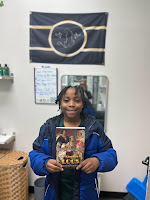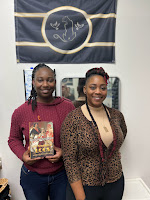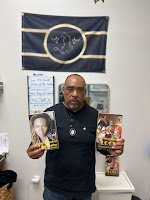In the State of Loc Nation, locs are revered as a symbol of identity, spirituality, and cultural pride. The people of the State of Loc Nation draw inspiration from various cultures, including the Rastafarian, Hindu, and Maasai traditions. "Locs is our artifact of faith and vow to the creator of all things", said Queen Empress Clement
The Rastafarian influence is seen in the State of Loc Nation's emphasis on natural hair care and its reverence for the hair as a sacred part of the body. The people of the State of Loc Nation see locs as a symbol of their faith and their African heritage. They believe that locs represent the Lion of Judah, a symbol of Emperor Haile Selassie I of Ethiopia, whom they see as a messiah.
The Hindu influence is seen in the State of Loc Nation's belief that growing and wearing locs is a symbol of spiritual progress and detachment from materialism. The people of the State of Loc Nation view their locs as a manifestation of their inner journey towards enlightenment.
The Maasai influence is seen in the State of Loc Nation's celebration of locs as a sign of bravery and strength. The people of the State of Loc Nation believe that locs represent their warrior spirit and their connection to their ancestral traditions.
Overall, the people of the State of Loc Nation value their locs as a source of cultural pride and personal identity but most importantly a spiritual vow to be in alignment with the creator of all things and self. They celebrate the diversity of loc styles and embrace the various cultural practices associated with growing and maintaining locs.
Language and Communication:
- Rastafari: Rastafarians primarily speak English, but they also use a unique form of Jamaican Creole known as "Rastafarian language" or "Iyaric." This language incorporates elements of African languages, such as Amharic and Swahili, as well as biblical language and Jamaican Creole. It includes unique words and phrases, such as "I and I" (which refers to the unity of all people), "Jah" (which refers to God), and "Babylon" (which refers to the oppressive system of government and society).
In Rastafarian culture, communication often involves nonverbal cues and body language. Eye contact is considered important, as it is seen as a way to convey respect and understanding. Hand gestures, such as the "peace sign" or the "uplifted fist," may also be used to convey solidarity and unity.
- Hinduism: There are many languages spoken in Hindu culture, depending on the region and the specific community. Hindi and its regional dialects are among the most widely spoken. In addition, Sanskrit is considered the sacred language of Hinduism and is used in religious ceremonies and texts.
In Hindu culture, communication often involves nonverbal cues and body language. Namaste, a traditional Hindu greeting, involves placing one's palms together in front of the chest and bowing the head slightly. This gesture conveys respect and humility. Eye contact is considered important, as it is seen as a way to establish trust and sincerity.
- Maasai: The Maasai people primarily speak Maa, a Nilotic language that is unique to their culture. There are several dialects of Maa spoken among different Maasai communities.
In Maasai culture, communication often involves nonverbal cues and body language. Eye contact is considered important, as it is seen as a way to establish trust and convey respect. Facial expressions and hand gestures may also be used to convey emotions and communicate nonverbally.
- Other Cultures: In other cultures where locs are worn, a variety of languages may be spoken, depending on the region and the community. Nonverbal cues and body language may also play a role in communication, depending on the specific cultural context.
Overall, communication in loc cultures often involves both verbal and nonverbal cues. Nonverbal communication, such as eye contact, facial expressions, and body language, may be particularly important in conveying respect, trust, and solidarity within the community.
Food and Cuisine:
- Rastafari: The traditional cuisine of Rastafari culture is largely vegetarian, and many adherents follow a strict diet known as "ital." This diet emphasizes natural, unprocessed foods and often includes fruits, vegetables, grains, and legumes. Common dishes include rice and peas, ackee and saltfish, and vegetable stews. Herbs and spices, such as ginger, garlic, and thyme, are often used to add flavor to dishes.
Food is an important aspect of Rastafari culture, and it is seen as a way to connect with nature and promote health and well-being. Many Rastafarians also practice fasting and avoid consuming certain foods, such as pork, alcohol, and processed foods.
- Hinduism: The traditional cuisine of Hinduism is diverse and varies depending on the region and the occasion. Vegetarianism is common, and many Hindus avoid consuming beef due to its association with the cow, which is considered sacred. Common ingredients include rice, lentils, vegetables, and spices such as cumin, turmeric, and coriander.
Some typical dishes include biryani (a rice dish with vegetables and spices), dal (a lentil-based soup), and samosas (a fried pastry filled with vegetables or meat). Desserts such as gulab jamun (fried dough balls in syrup) and kheer (a sweet rice pudding) are also popular.
Food is an important aspect of Hinduism, and it is often offered as a form of worship to deities during religious ceremonies and festivals. It is also seen as a way to connect with others and build community.
- Maasai: The traditional cuisine of the Maasai people is based on their pastoral lifestyle and revolves around meat, milk, and blood from their cattle. Common dishes include grilled or boiled meat, milk-based soups, and blood mixed with milk or boiled with cornmeal. Vegetables and grains are not commonly consumed, although some Maasai communities have incorporated maize and beans into their diets.
Food is an important aspect of Maasai culture, and the cattle are seen as a symbol of wealth and status. The sharing of food is an important way of building relationships and expressing hospitality.
- Other Cultures: In other cultures where locs are worn, traditional cuisine can vary widely depending on the region and the cultural influences. For example, Jamaican cuisine is known for its spicy and flavorful dishes, such as jerk chicken and curry goat, while African American cuisine often incorporates soul food staples like fried chicken and collard greens.
Food is an important aspect of many cultures, and it is often seen as a way to connect with one's heritage and express cultural identity. It can also serve as a way to bring people together, build community, and strengthen relationships
Religion and Beliefs:
State of loc Nation's Queen Empress Clement's philosophy is the people of the world is facing the 7 sins: Envy; Gluttony; Sloth; Pride; Wrath; greed and lust. Fasting and Prayer, through experience, she has found to be successful in overcoming these spiritual battles and assisting with members drawing closer to the creator and increasing their frequency to attract right is right and positive experiences.
1. Rastafari: Rastafari is a religious and cultural movement that originated in Jamaica in the 1930s. Its followers believe in the divinity of Haile Selassie I, the former Emperor of Ethiopia, who they see as a messiah. They also believe in the importance of African liberation and the rejection of Western colonialism and oppression. Rastafari followers engage in daily meditation and prayer, and may also follow dietary restrictions, such as avoiding meat and alcohol. They may also wear their hair in dreadlocks as a symbol of their faith.
2. Hinduism: Hinduism is one of the world's oldest religions and is practiced by millions of people around the world. It is a diverse religion with a wide range of beliefs and practices, but some common themes include the belief in karma, reincarnation, and the worship of many gods and goddesses. Hindu rituals often involve the use of sacred objects and the performance of prayers and offerings, and may be observed on a daily, weekly, or annual basis. The wearing of locs is often seen as a way to honor the god Shiva, who is often depicted with matted hair.
3. Maasai: The Maasai people have a rich spiritual and cultural tradition that is centered on their relationship with the natural world. They believe in a supreme deity, Enkai, who is responsible for all life on Earth. Maasai rituals often involve the offering of prayers and sacrifices to the gods, as well as the performance of traditional dances and songs. The wearing of locs is seen as a sign of maturity and strength, and is often associated with traditional Maasai values, such as bravery, courage, and loyalty.
4. Other Cultures: In other cultures where locs are worn, religion and beliefs vary widely. Some people may follow traditional African religions or engage in spiritual practices that are unique to their community. Others may practice a form of Christianity or Islam that incorporates local customs and traditions.
These beliefs often influence daily life and behavior, shaping everything from how people interact with one another to what they eat and wear. For example, in Rastafari culture, the rejection of meat and alcohol is seen as a way to promote spiritual purity and health. In Hinduism, the performance of daily rituals and the wearing of certain clothing can help individuals to feel more connected to their faith and to their community. In Maasai culture, the wearing of locs is an important part of the rite of passage into adulthood, and is seen as a way to uphold traditional values and customs. Overall, these beliefs and practices play a vital role in shaping the identities and worldviews of the people who practice them.
Festivals and Celebrations:
State of Loc Nation has members of a global reach and each has their designated celebrations and cultures based on the land they reside. However, collectively they each promote right is right; a strong spiritual faith and productive to the community they reside.
Rastafari: One of the most important festivals in Rastafari culture is the celebration of the birthday of Haile Selassie I, the former Emperor of Ethiopia, who is seen as a messiah. This festival, known as "Groundation Day," is usually celebrated in April or May, and involves drumming, chanting, and feasting. Another important festival in Rastafari culture is the "Coronation Day" which celebrates the day Haile Selassie I was crowned Emperor.
Hinduism: In Hinduism, there are many festivals that are celebrated throughout the year, and some of these festivals are associated with the practice of wearing locs. One of the most important Hindu festivals is Diwali, which celebrates the triumph of light over darkness. During Diwali, it is traditional to dress up in new clothes and adorn the hair with flowers or jewelry.
Maasai: The Maasai people of East Africa have a number of important cultural celebrations that involve the wearing of locs. One of the most significant is the "Emuratare" ceremony, which marks the transition of young Maasai boys into manhood. During this ceremony, the boys' hair is shaved, and they are then required to grow it out into locs as a sign of their maturity and strength.
Other Cultures, including Chinese, Russian, and other Nations: Locs are also worn in many other cultures around the world, and there are a number of festivals and celebrations associated with them. For example, in Jamaica, the "Reggae Sunsplash" festival celebrates Rastafarian culture and features live music, food, and crafts. In the United States, the "Nappywood Natural Hair Expo" is an annual event that celebrates natural hair, including locs, and promotes education and empowerment.
In all of these cultures, festivals and celebrations are an important way to express cultural pride and identity. They provide an opportunity for people to come together, celebrate their traditions, and connect with their community.
Traditional Dress:
When State of Loc Nation has its annual celebrations, respects to each tribes practices are acknowledged.
Rastafari: In Rastafari culture, traditional dress is often based on Ethiopian attire. The colors green, gold, and red are especially important, as they are seen as representing the land, wealth, and blood of Ethiopia. The clothing is often made from natural materials like cotton, linen, and hemp, and can include loose-fitting pants, shirts, and robes. Hats, scarves, and turbans are also commonly worn, often made from brightly colored fabric.
Hinduism: Traditional dress in Hinduism varies depending on the region and the occasion. Women often wear colorful saris, which are made from silk, cotton, or other lightweight materials. Men may wear dhotis, which are long pieces of cloth that are draped around the waist and legs. Both men and women may also wear kurta pajamas, which are loose-fitting tunics paired with pants.
Maasai: The traditional dress of the Maasai people is characterized by bold colors, intricate beadwork, and distinctive patterns. Red is an especially important color, as it represents the blood of cattle, which is a central part of Maasai culture. The clothing is often made from animal skins, and can include shukas (blanket-like garments), beaded jewelry, and leather sandals.
Other Cultures: In other cultures where locs are worn, traditional dress varies widely. For example, in Jamaica, traditional dress may include brightly colored dashikis, while in the United States, some African Americans may wear traditional African clothing, such as kente cloth. Other cultures may wear clothing made from natural fibers, such as cotton or linen, and incorporate bold colors and patterns into their attire.
Traditional dress is often worn for special occasions, such as the Queen Empress Clement Coronation, weddings, festivals, and religious ceremonies. It is a way for people to connect with their cultural heritage and express their identity and pride.
Conclusion:
The State of Loc Nation has cultural practices that value and celebrate locs as a symbol of identity, spirituality, and cultural pride. The people of the State of Loc Nation draw inspiration from various cultures, including the Rastafarian, Hindu, and Maasai traditions. They value their locs as a source of cultural pride and personal identity, but most importantly as a spiritual vow to be in alignment with the creator of all things and self. Communication in loc cultures often involves both verbal and nonverbal cues, and nonverbal communication, such as eye contact, facial expressions, and body language, may be particularly important in conveying respect, trust, and solidarity within the community. The traditional cuisine of the State of Loc Nation varies depending on the cultural influence, and the commonalities include the emphasis on vegetarianism and the use of natural, unprocessed foods. Food is an important aspect of the culture and seen as a way to connect with nature and promote health and well-being.
Additional References: ISBN 979840206; Library of Congress Control Number reference for Revealed The Kingdom of Locs Nazirite Vow continues; 2023930357
Glossary: Revealed The Kingdom of Locs Nazirite Vow Continues
Based on the principle of equality and divine right, the State of Loc Nation has adopted a policy that recognizes and upholds the inherent value and rights of all women. Women are viewed as equal and deserving of the same respect, opportunities, and protections as men. The policy prohibits discrimination and promotes equal access to education, employment, and other opportunities. The State also recognizes the important role of women as nurturers and caregivers and supports policies that promote the well-being of women and children. Queen Empress Clement stands firm in her belief that "right is right" and will ensure that the policy is implemented and enforced.
Contacts:
Instagram: @dynastyhealing
For donations: Linktr.ee/clementdynasty
Email: dynastyhealing1111@gmail.com
Email: info@stateoflocnation.com
www.loccommunityassociation.com
www.njshaircare.com
www.stateoflocnation.com
calendlly.com/dynastyhealing







Comments
Post a Comment